实验3:OpenFlow协议分析实践
实验3:OpenFlow协议分析实践
实验要求
(一)基本要求
1.搭建下图所示拓扑,完成相关 IP 配置,并实现主机与主机之间的 IP 通信。用抓包软件获取控制器与交换机之间的通信数据包。



2.查看抓包结果,分析OpenFlow协议中交换机与控制器的消息交互过程,画出相关交互图或流程图。
- HELLO
源端口6633 -> 目的端口46370,从控制器到交换机,协议为openflow1.0
![]()
源端口52458 -> 目的端口6633,从控制器到交换机,协议为openflow1.0
![]()
- FEATURES_REQUEST
源端口6633 -> 目的端口46370,从控制器到交换机
![]()
- FEATURES_REPLY
源端口46370 -> 目的端口6633,从交换机到控制器
![]()
- SET_CONFIG
源端口6633 -> 目的端口46370,从控制器到交换机
![]()
控制器要求交换机按照所给出的信息进行配置
- OFPT_PORT_STATUS
源端口46370 -> 目的端口6633,从交换机到控制器
![]()
控制器要求交换机按照所给出的信息进行配置
- OFPT_PACKET_IN
源端口46370 -> 目的端口6633,从交换机到控制器
![]()
交换机告知控制器有数据包进来,请求控制器指示
- OFPT_PACKET_OUT
源端口6633 -> 目的端口46370,从控制器到交换机
![]()
控制器要求交换机按照所给出的action进行处理
- OFPT_FLOW_MOD
源端口6633 -> 目的端口46372,从控制器到交换机
![]()
控制器对交换机进行流表的添加、删除、变更等操作
- 交互图
![]()
(二)进阶要求
将抓包结果对照OpenFlow源码,了解OpenFlow主要消息类型对应的数据结构定义。
- HELLO
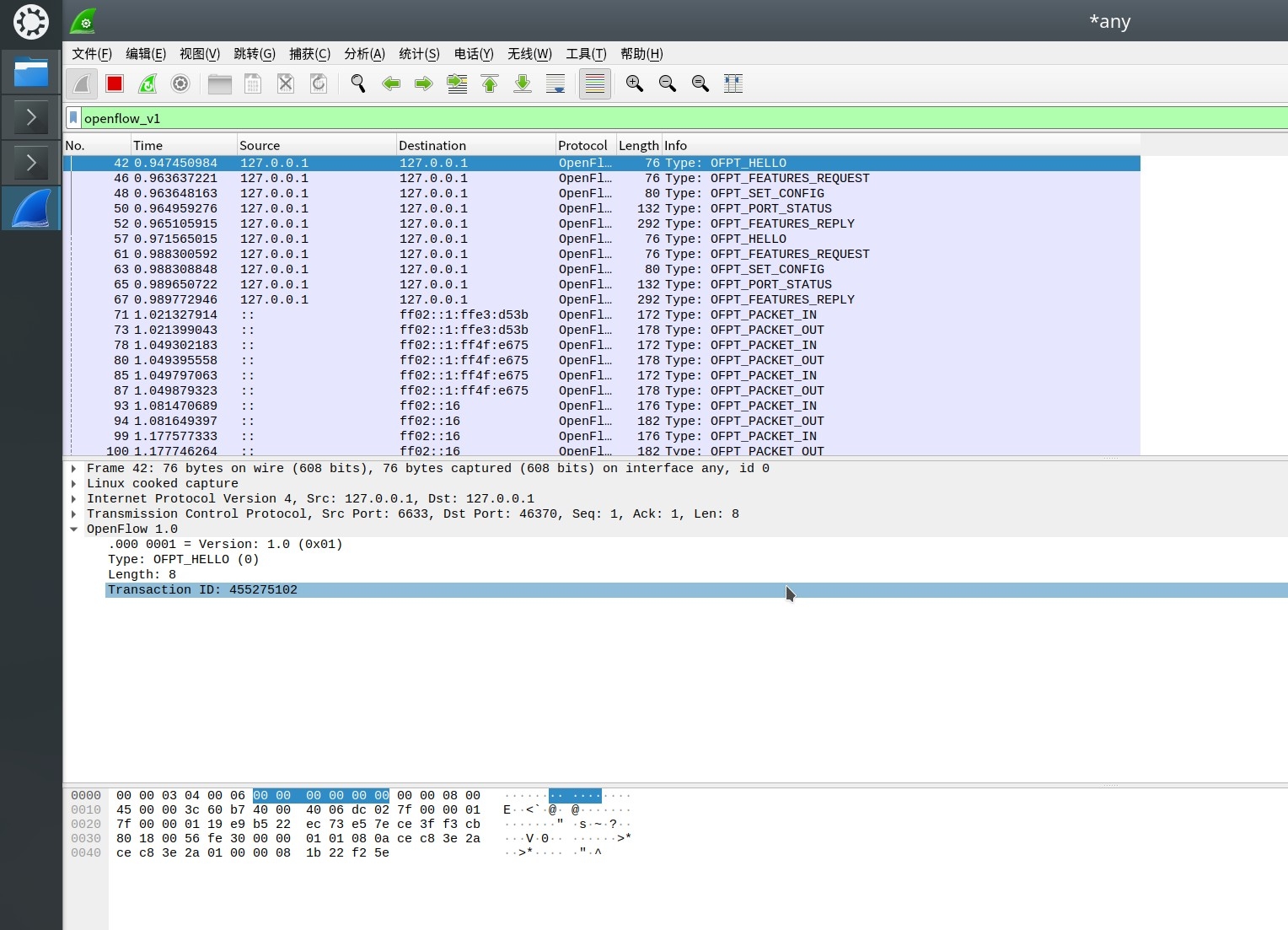
struct ofp_header {
uint8_t version; /* OFP_VERSION. */
uint8_t type; /* One of the OFPT_ constants. */
uint16_t length; /* Length including this ofp_header. */
uint32_t xid; /* Transaction id associated with this packet.
Replies use the same id as was in the request
to facilitate pairing. */
};
struct ofp_hello {
struct ofp_header header;
};
可以看到,ofp_header结构体内的的version,type,length,xid变量与图中显示的属性一一对应
- FEATURES_REQUEST

格式与上述ofp_header结构体中数据相同
- FEATURES_REPLY
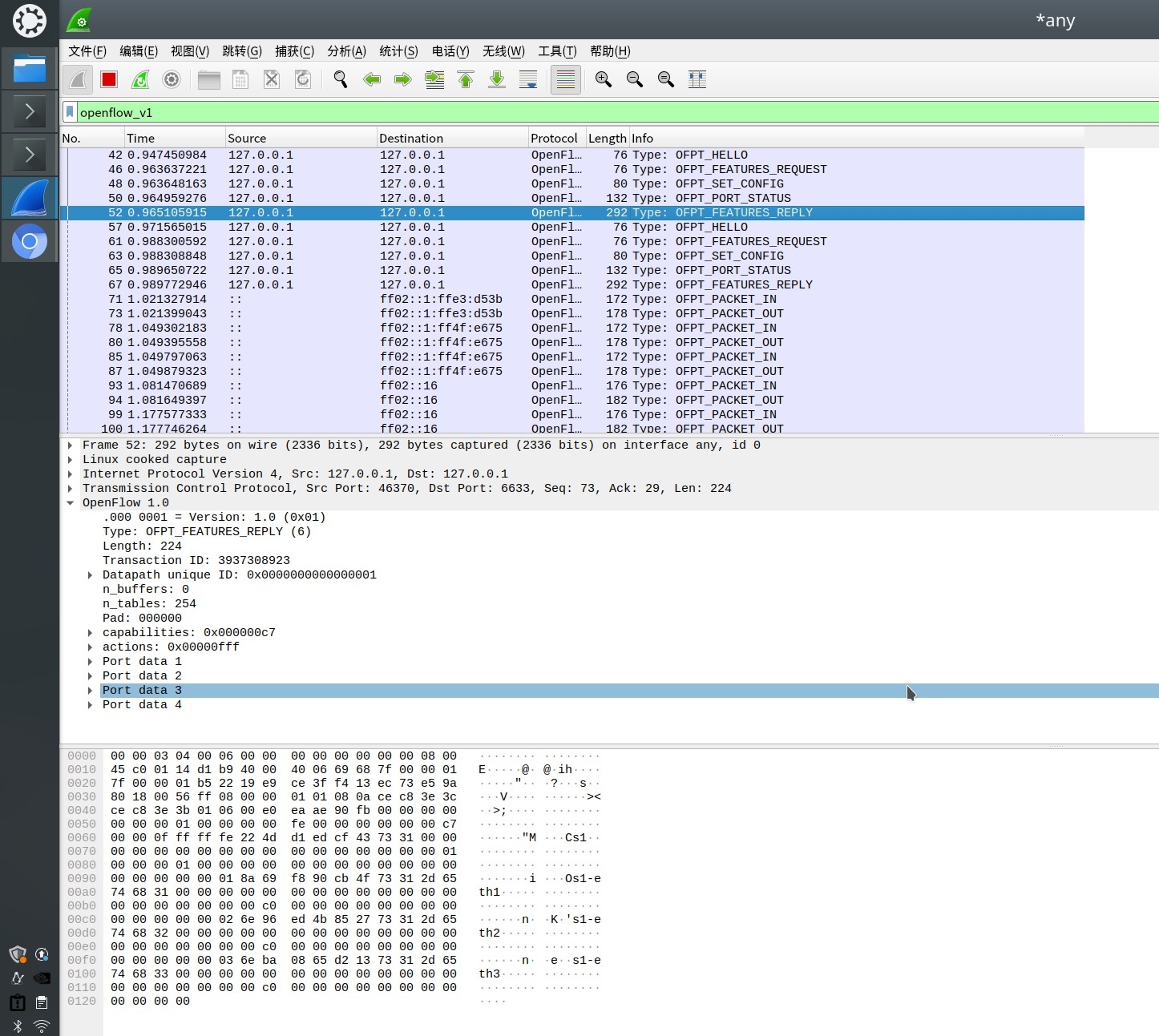
struct ofp_switch_features {
struct ofp_header header;
uint64_t datapath_id; /* Datapath unique ID. The lower 48-bits are for
a MAC address, while the upper 16-bits are
implementer-defined. */
uint32_t n_buffers; /* Max packets buffered at once. */
uint8_t n_tables; /* Number of tables supported by datapath. */
uint8_t pad[3]; /* Align to 64-bits. */
/* Features. */
uint32_t capabilities; /* Bitmap of support "ofp_capabilities". */
uint32_t actions; /* Bitmap of supported "ofp_action_type"s. */
/* Port info.*/
struct ofp_phy_port ports[0]; /* Port definitions. The number of ports
is inferred from the length field in
the header. */
};
/* Description of a physical port */
struct ofp_phy_port {
uint16_t port_no;
uint8_t hw_addr[OFP_ETH_ALEN];
char name[OFP_MAX_PORT_NAME_LEN]; /* Null-terminated */
uint32_t config; /* Bitmap of OFPPC_* flags. */
uint32_t state; /* Bitmap of OFPPS_* flags. */
/* Bitmaps of OFPPF_* that describe features. All bits zeroed if
* unsupported or unavailable. */
uint32_t curr; /* Current features. */
uint32_t advertised; /* Features being advertised by the port. */
uint32_t supported; /* Features supported by the port. */
uint32_t peer; /* Features advertised by peer. */
};
- SET_CONFIG
![]()
/* Switch configuration. */
struct ofp_switch_config {
struct ofp_header header;
uint16_t flags; /* OFPC_* flags. */
uint16_t miss_send_len; /* Max bytes of new flow that datapath should
send to the controller. */
};
可以看到源码与图中信息一一对应
- PORT_STATUS
![]()
/* A physical port has changed in the datapath */
struct ofp_port_status {
struct ofp_header header;
uint8_t reason; /* One of OFPPR_*. */
uint8_t pad[7]; /* Align to 64-bits. */
struct ofp_phy_port desc;
};
- PACKET_IN
![]()
struct ofp_packet_in {
struct ofp_header header;
uint32_t buffer_id; /* ID assigned by datapath. */
uint16_t total_len; /* Full length of frame. */
uint16_t in_port; /* Port on which frame was received. */
uint8_t reason; /* Reason packet is being sent (one of OFPR_*) */
uint8_t pad;
uint8_t data[0]; /* Ethernet frame, halfway through 32-bit word,
so the IP header is 32-bit aligned. The
amount of data is inferred from the length
field in the header. Because of padding,
offsetof(struct ofp_packet_in, data) ==
sizeof(struct ofp_packet_in) - 2. */
};
- PACKET_OUT
![]()
struct ofp_packet_out {
struct ofp_header header;
uint32_t buffer_id; /* ID assigned by datapath (-1 if none). */
uint16_t in_port; /* Packet's input port (OFPP_NONE if none). */
uint16_t actions_len; /* Size of action array in bytes. */
struct ofp_action_header actions[0]; /* Actions. */
/* uint8_t data[0]; */ /* Packet data. The length is inferred
from the length field in the header.
(Only meaningful if buffer_id == -1.) */
};
- FLOW_MOD
![]()
struct ofp_flow_mod {
struct ofp_header header;
struct ofp_match match; /* Fields to match */
uint64_t cookie; /* Opaque controller-issued identifier. */
/* Flow actions. */
uint16_t command; /* One of OFPFC_*. */
uint16_t idle_timeout; /* Idle time before discarding (seconds). */
uint16_t hard_timeout; /* Max time before discarding (seconds). */
uint16_t priority; /* Priority level of flow entry. */
uint32_t buffer_id; /* Buffered packet to apply to (or -1).
Not meaningful for OFPFC_DELETE*. */
uint16_t out_port; /* For OFPFC_DELETE* commands, require
matching entries to include this as an
output port. A value of OFPP_NONE
indicates no restriction. */
uint16_t flags; /* One of OFPFF_*. */
struct ofp_action_header actions[0]; /* The action length is inferred
from the length field in the
header. */
};
struct ofp_action_header {
uint16_t type; /* One of OFPAT_*. */
uint16_t len; /* Length of action, including this
header. This is the length of action,
including any padding to make it
64-bit aligned. */
uint8_t pad[4];
};
总结
本次实验我们使用wireshark抓去网络数据包,验证了在OpenFlow协议下控制器与交换机建立链接与相互交互的过程。本次实验的操作难度不大,我们只需注意搭建拓扑时修改好响应的网段与IP地址即可,但所需验证的理论知识多,所以本次实验的难度还是较大。分析wireshark所抓取的数据包,结合源码分析,使我对OpenFlow协议有了更进一步的了解。实验过程中由于直接使用openflow_v1作为筛选条件,导致我无法看到交换机发送给控制器的hello包,后来发现这个问题时采用openflow_v5抓去该hello信息已经是再一次构建该网络了,所以实验报告中两部分的地址对应不上。


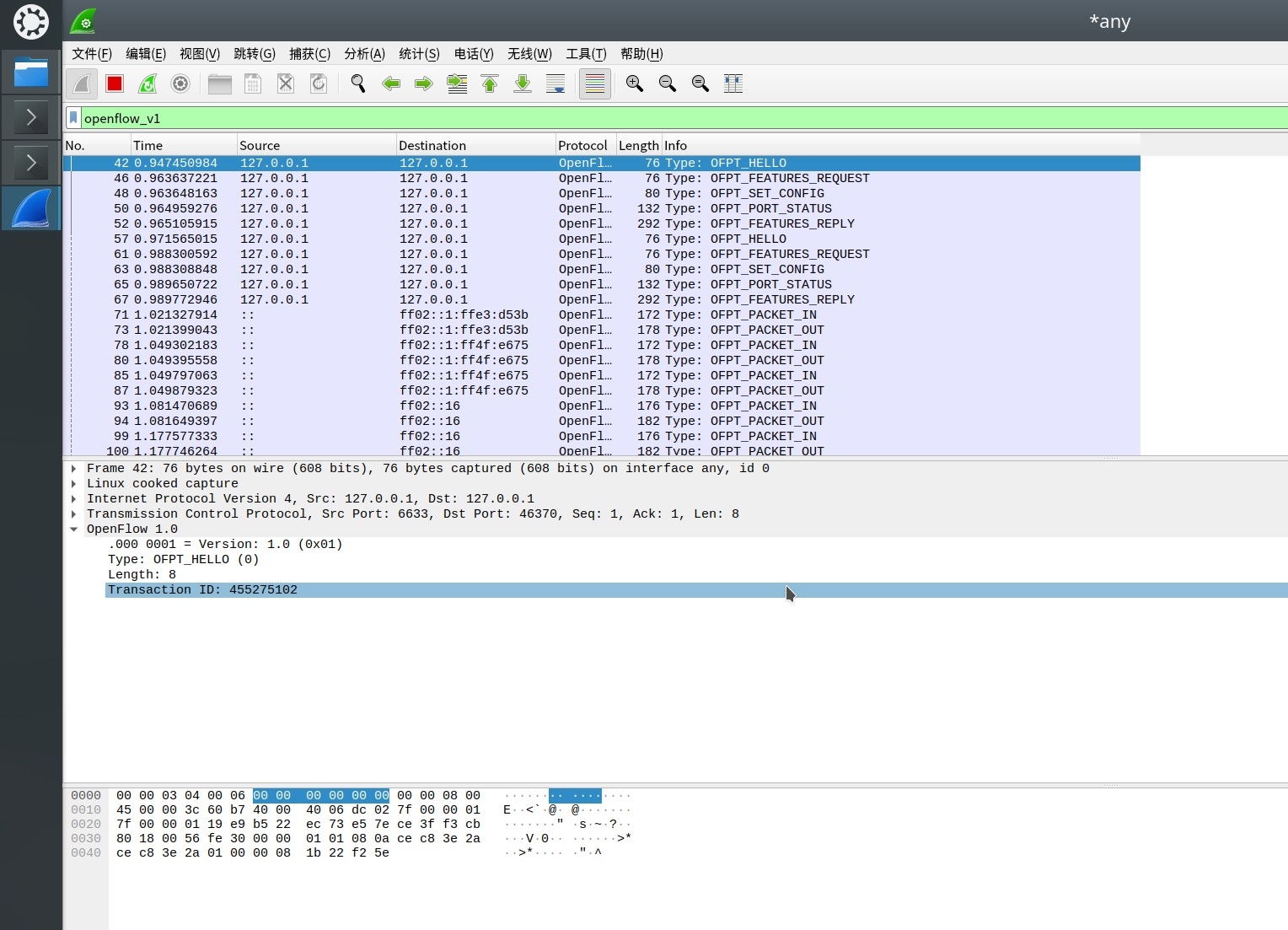
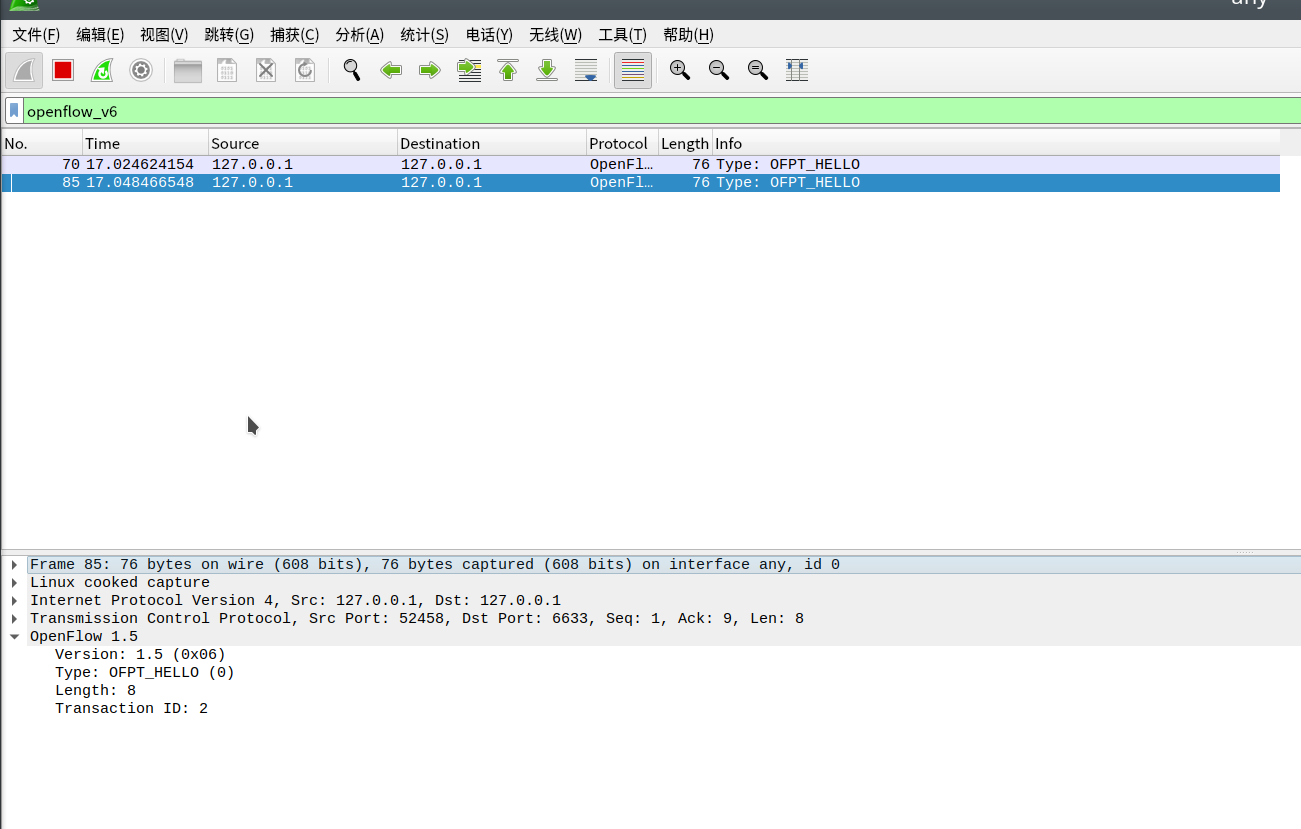
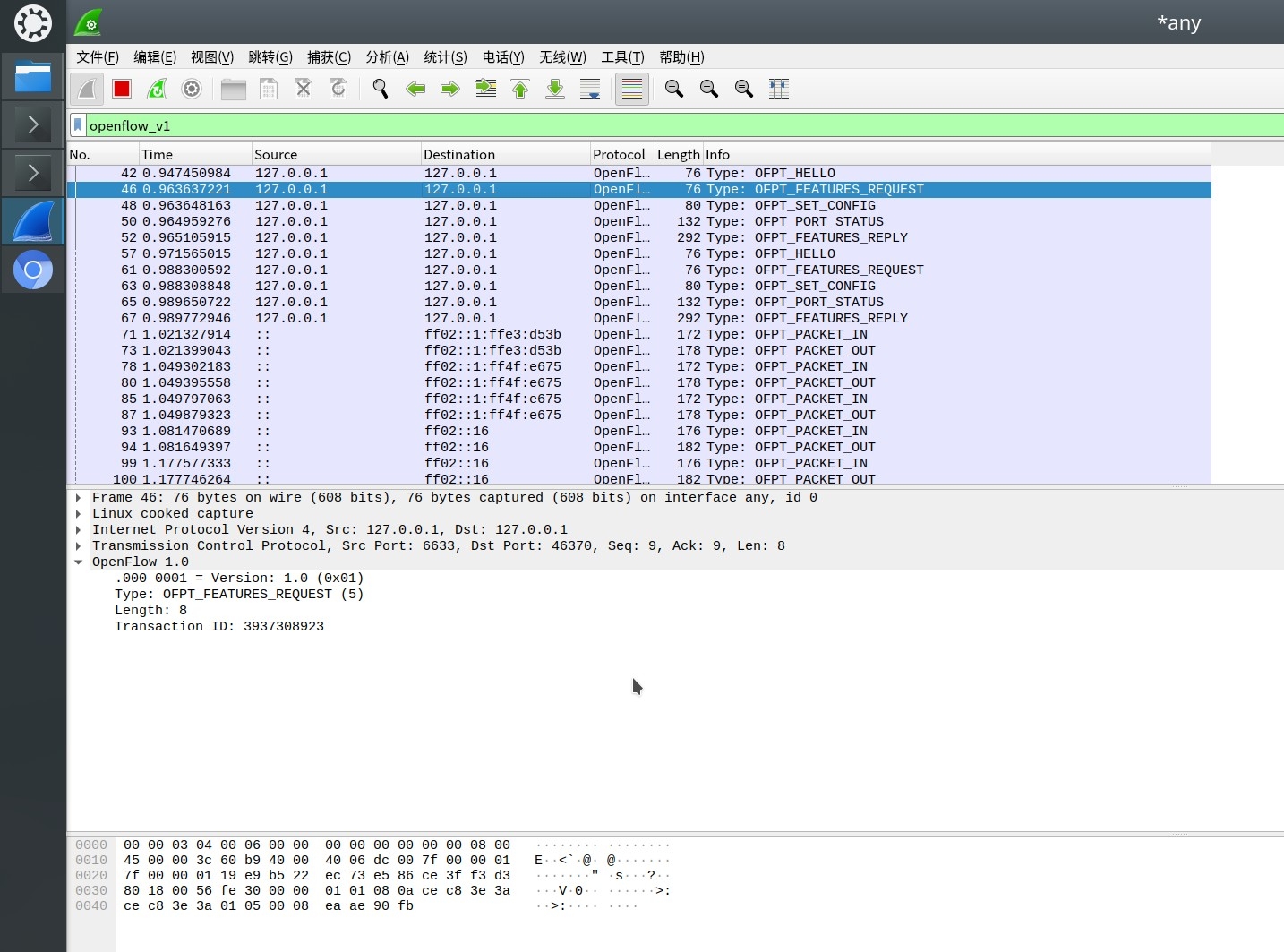
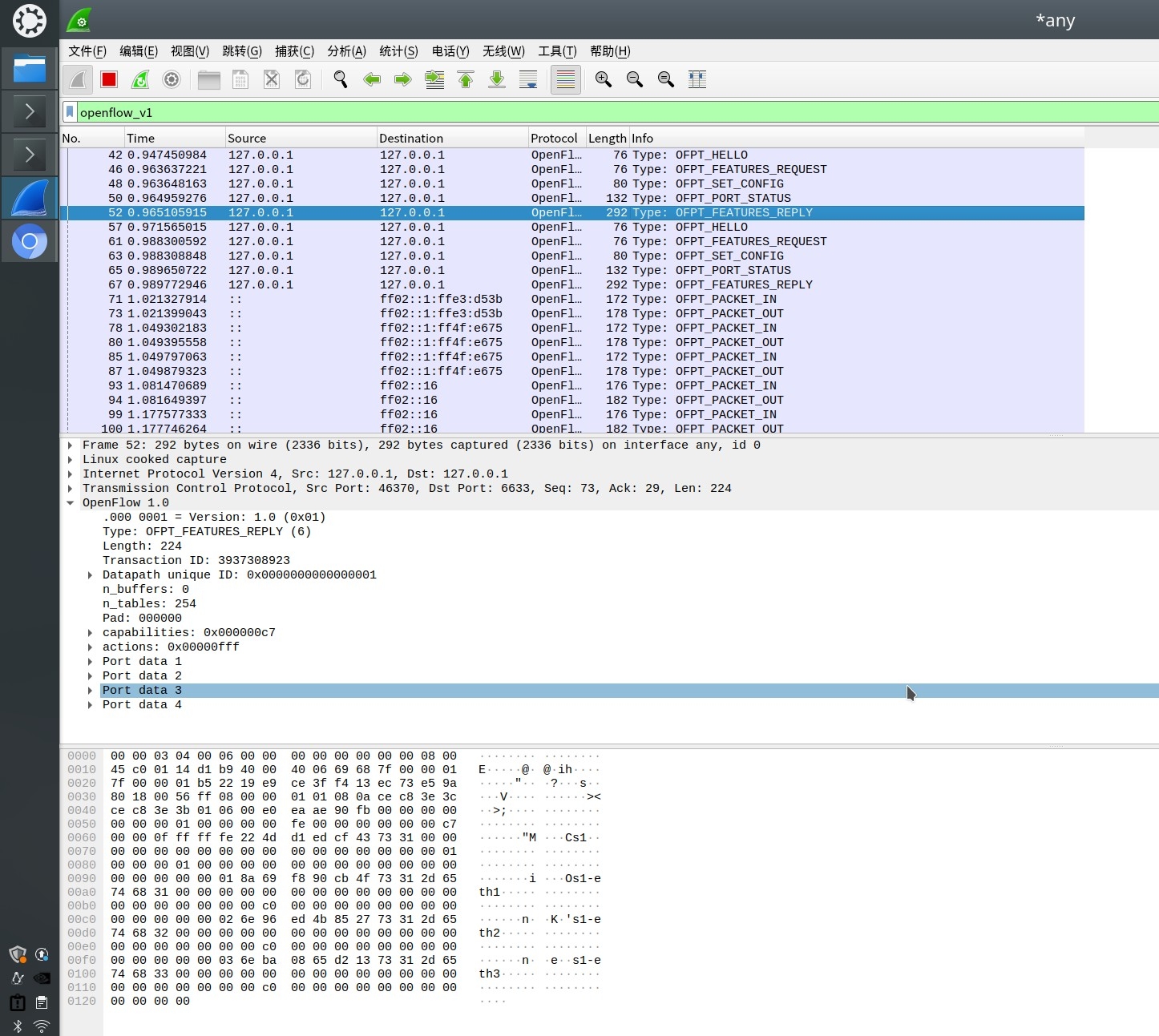


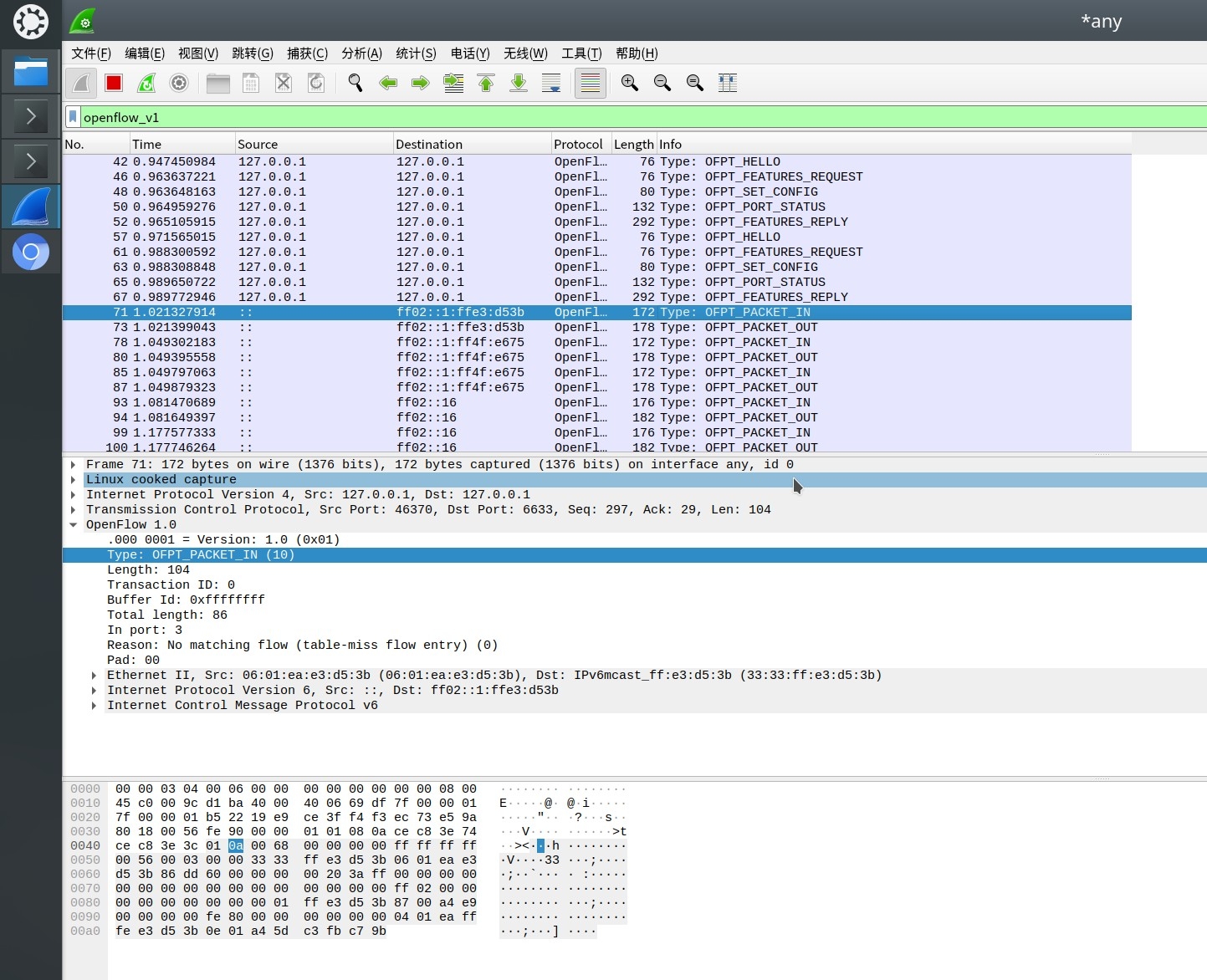

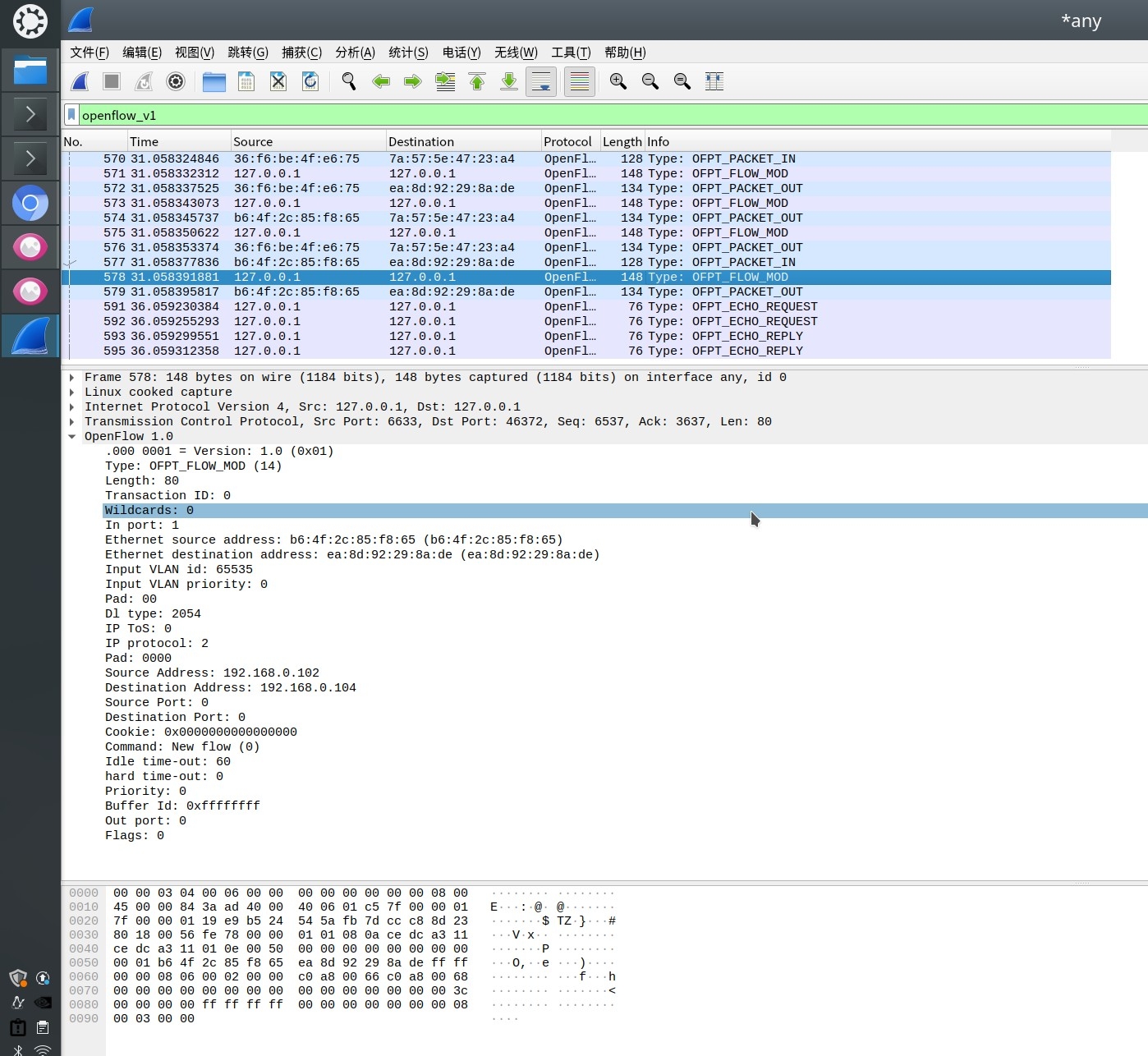
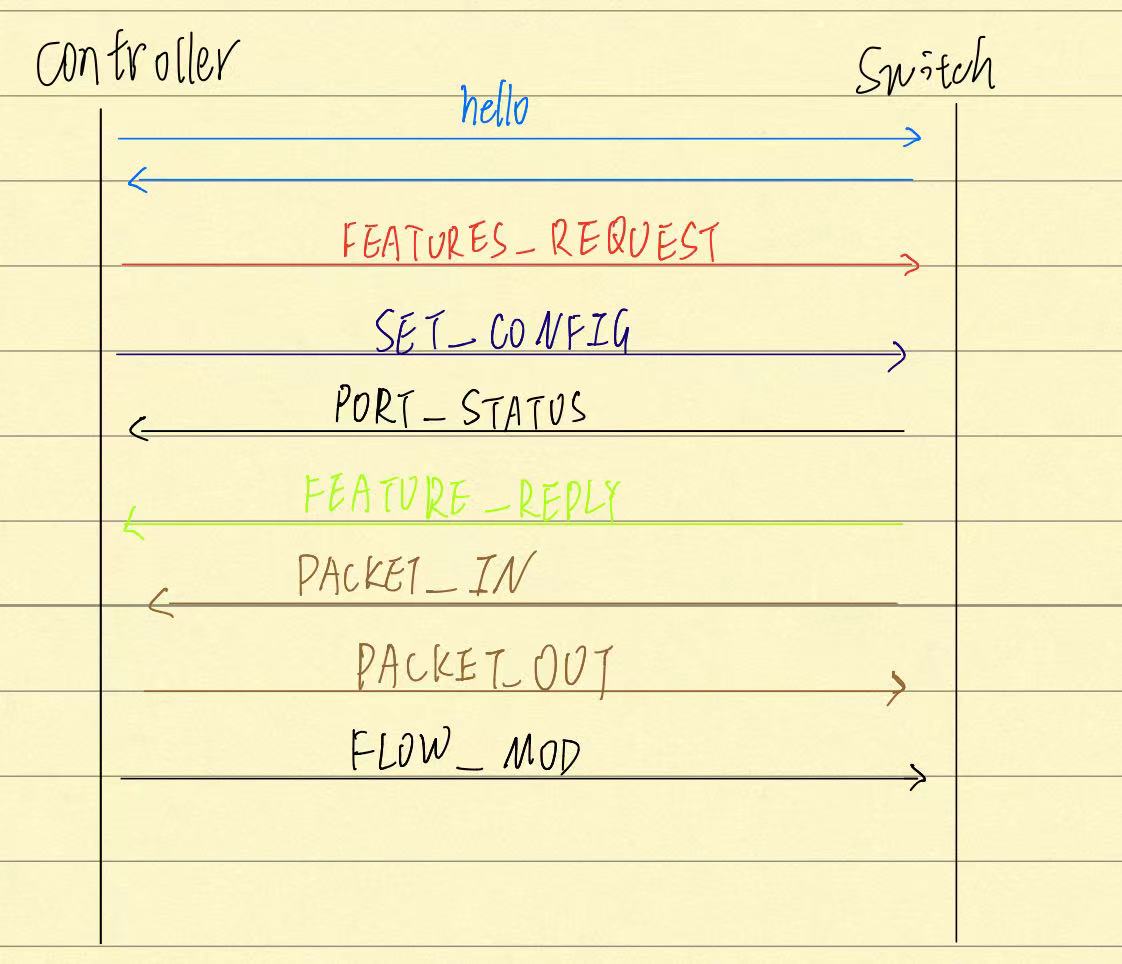


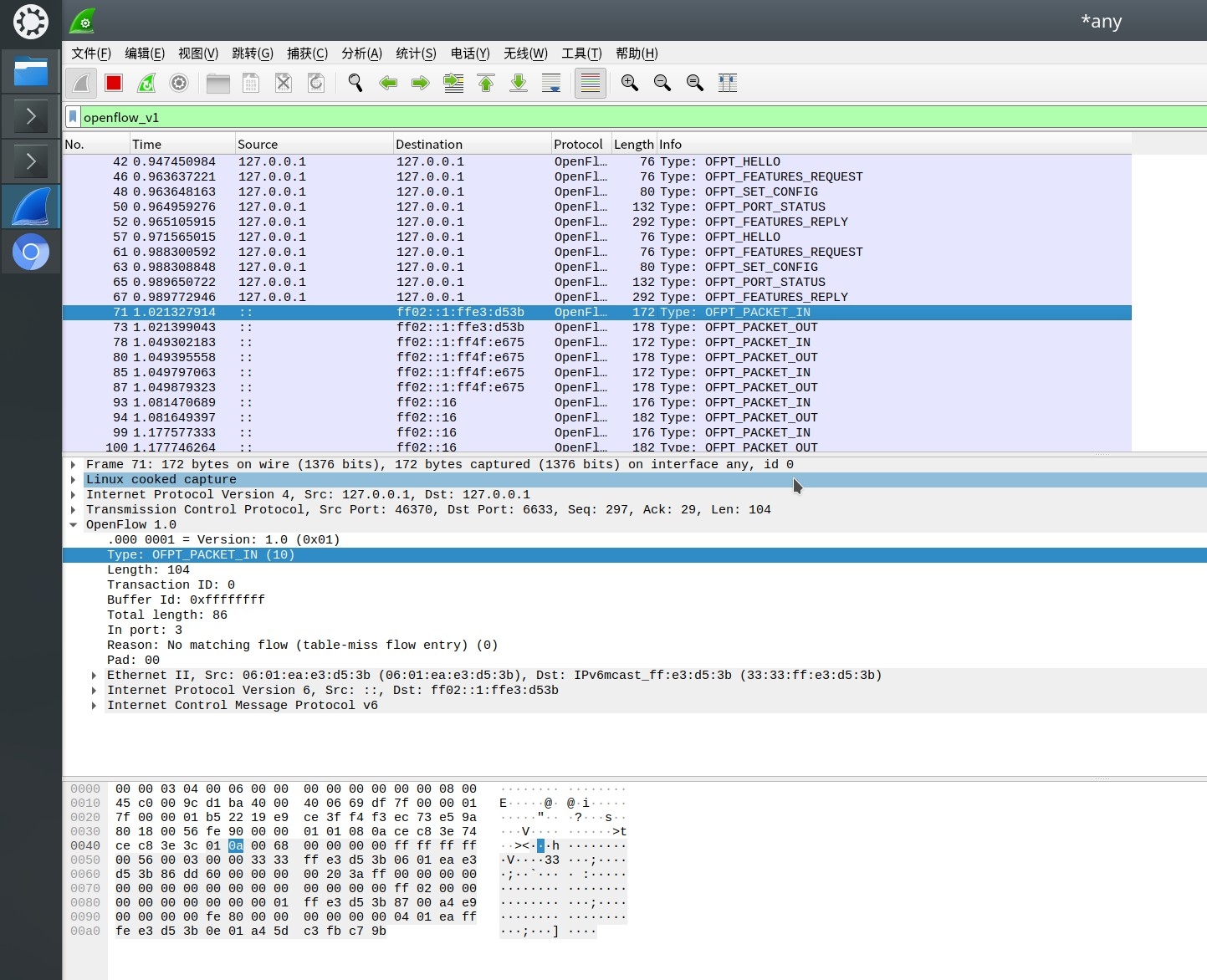

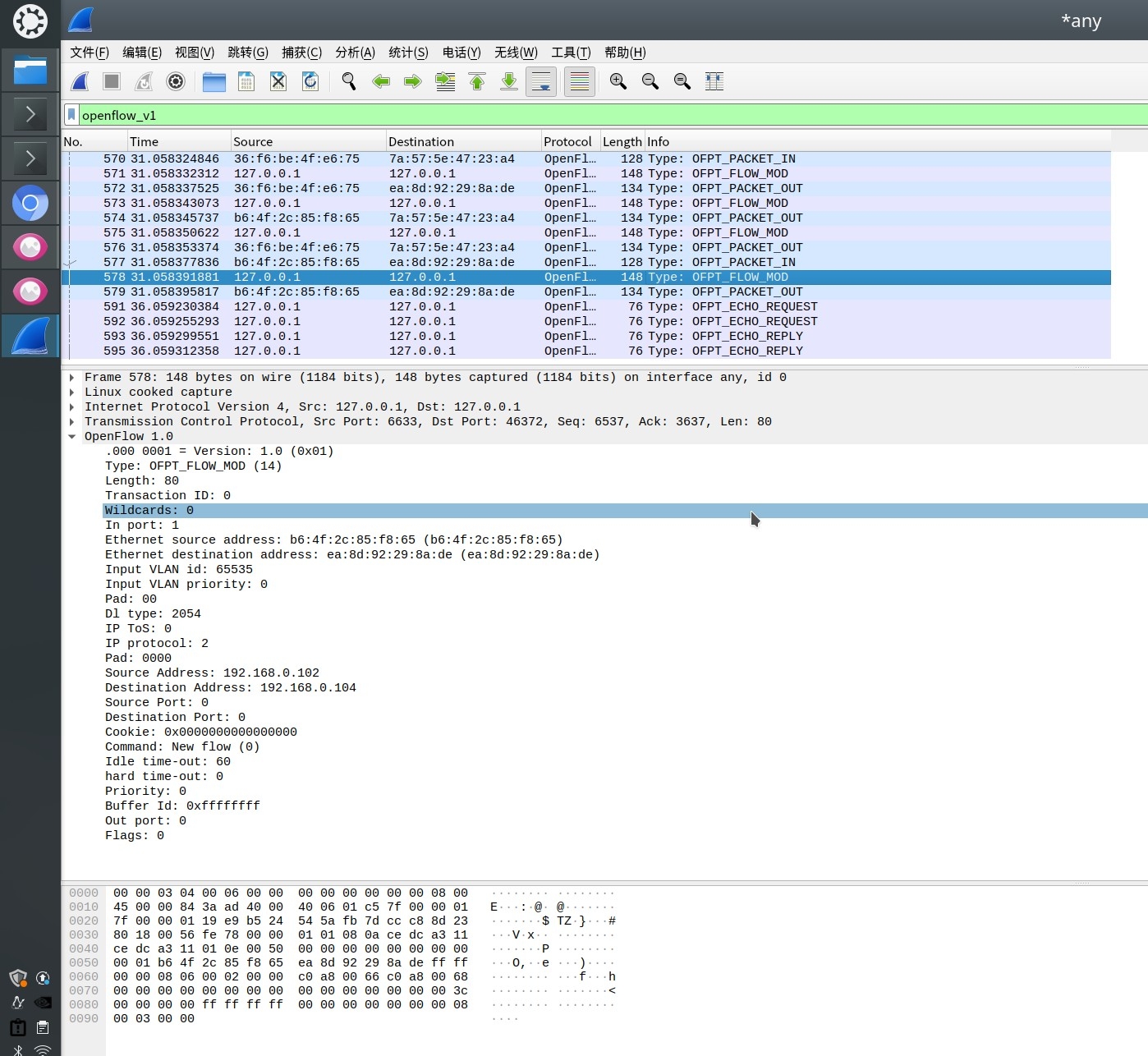

 浙公网安备 33010602011771号
浙公网安备 33010602011771号